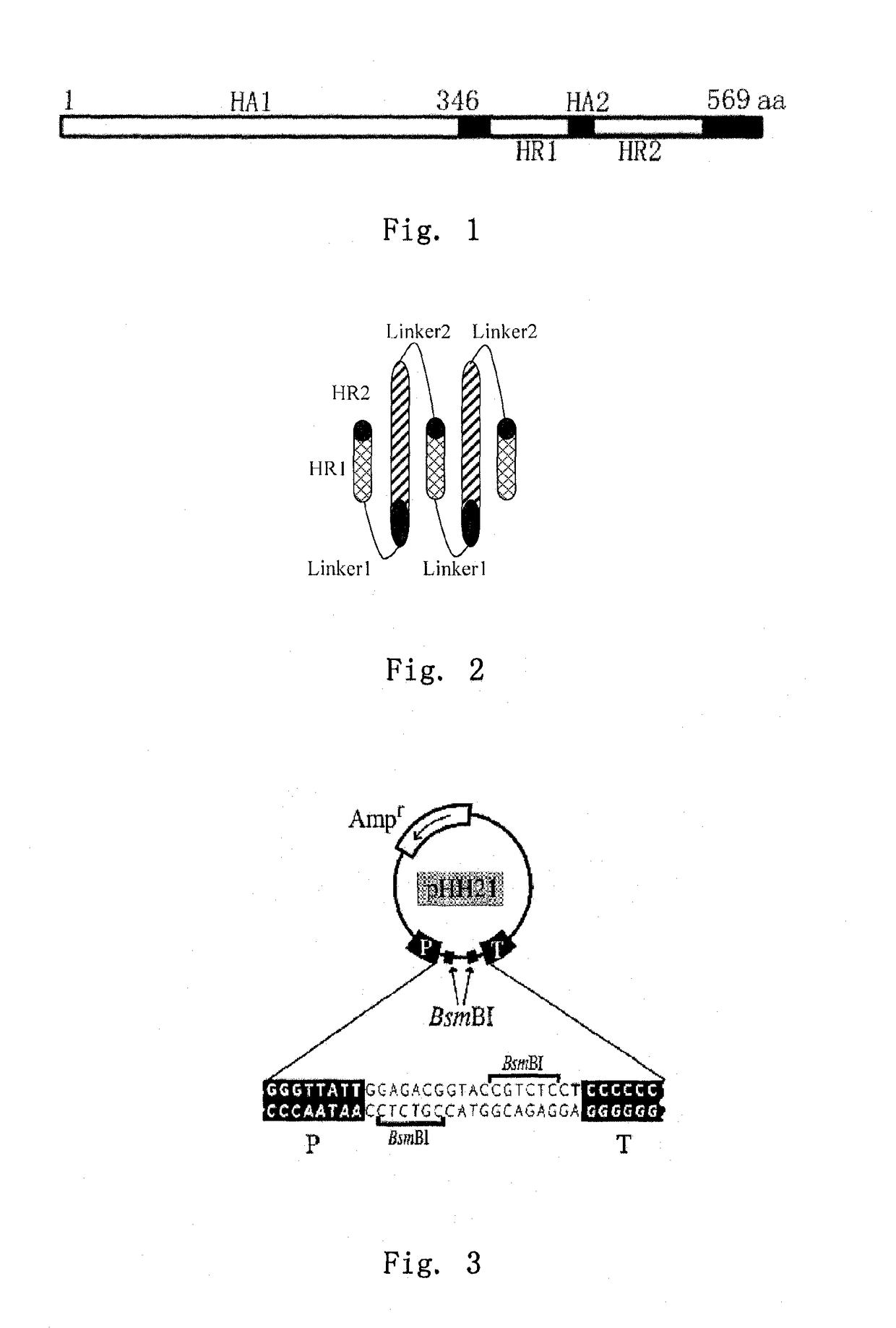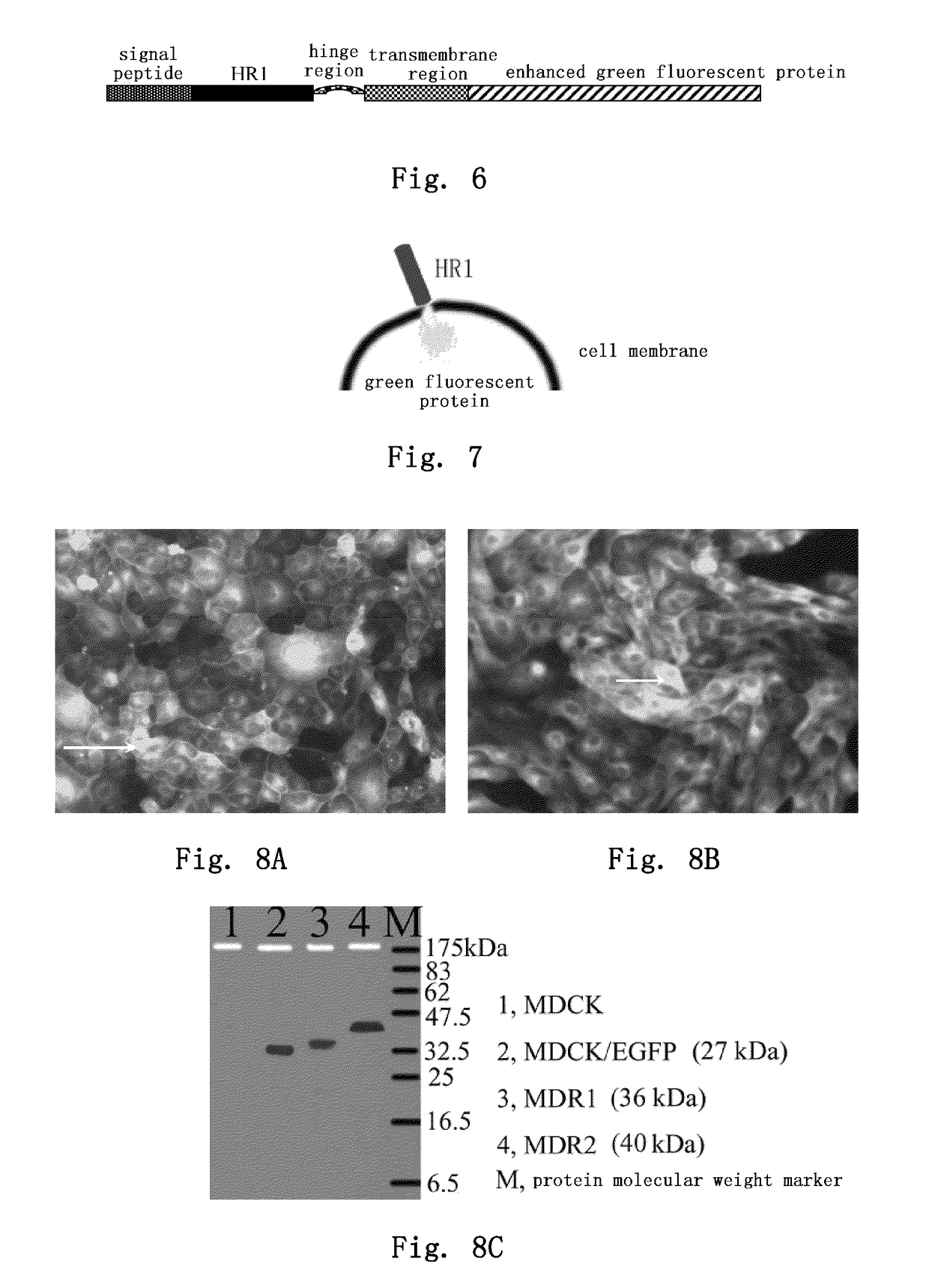Method and medicament for inhibiting the infection of influenza virus
a technology of enveloped viruses and medicine, which is applied in the direction of biocide, drug composition, peptide/protein ingredients, etc., can solve the problems of affecting the prophylaxis and treatment of influenza virus, affecting the survival and breeding of various animals, and causing severe endangering the survival of various animals
- Summary
- Abstract
- Description
- Claims
- Application Information
AI Technical Summary
Benefits of technology
Problems solved by technology
Method used
Image
Examples
example 1
Construction of the Viral RNA Expression Vectors for HA and NA Genes of the Highly Pathogenic Avian Influenza Virus Strain A / Bar-headed Goose / Qinghai / 1 / 05
1.1) Extraction of Viral RNA
[0056]The highly pathogenic avian influenza virus strain A / bar-headed goose / Qinghai / 1 / 05 (shortened as strain “QH” hereinafter) is the highly pathogenic avian influenza virus H5N1, which was isolated and stored in our lab (see Liu et al, 2005). The allantoic fluid of chicken embryo containing influenza virus strain QH stored at −70° C. was centrifuged at 3000 r / m for 10 min to remove protein impurities. Subsequently, 140 μl of supernatant was pipetted into a 1.5 ml RNase-free centrifuge tube. Viral RNA was extracted using a virus RNA extraction kit (QIAmp Viral RNA Mini Kit, CAT. No. 52904), according to the instruction of the manufacture. After extraction, adsorption, wash, centrifuge, and elution, 60 μl of viral RNA solution was obtained, and then packed in aliquots and stored at −80° C.
1.2) RT-PCR Amp...
example 2
Preparation of Recombinant Influenza Virus WSN and QH-WSN
2.1) Preparation of Recombinant Influenza Virus WSN
[0064]The recombinant human influenza virus A / WSN / 33 (H1N1 subtype, sometimes shortened as “WSN” hereinafter) was prepared using a reverse genetic system of influenza virus with 12 plasmids (Luytjes et al, 1989). The reverse genetic system with 12 plasmids was gifted from Prof. Yoshihiro Kawaoka in University of Wisconsin, USA (Neumann et al; 1999). Such system comprises the expression plasmids for expressing 8 negative-strand RNA fragments in influenza virus genome (including pHH21-PB2, pHH21-PB1, pHH21-PA, pHH21-HA, pHH21-NP, pHH21-NA, pHH21-M and pHH21-NS) and 4 protein expression plasmids for expressing replicase complex of influenza virus (including pcDNA3-PB2, pcDNA3-PB1, pcDNA3-PA and pCAGGS-NP). E. coli competent DH5α cells were transformed with the above plasmids respectively. A single clone was picked and cultured in LB medium for 6 hours or long. Plasmids were extra...
example 3
Plaque Potency Test of Experimental Influenza Virus
[0066]In order to test inhibitory effect of the inventive polypeptide and protein on the highly pathogenic avian influenza virus, we detected their inhibitory effect on recombinant virus QH-WSN possessing an infectious feature of the highly pathogenic avian H5N1 influenza virus. On the other hand, for the purpose of testing whether the above polypeptide and protein have a crossing inhibitory effect on human influenza virus, we detected their inhibitory effect on recombinant virus WSN (human influenza virus) which has a similar genetic background with QH-WSN but possesses a H1N1 subtype surface membrane protein. In addition, we also detected their crossing inhibitory effect on a representative strain (A / Jiangxi / 312 / 2005; shortened as strain “JX”) of human H3N2 influenza virus isolated from the southern China in 2005 (Lanyu et al., 2006).
[0067]Since a canine kidney passage cell (MDCK) is a sensitive cell strain suitable for growing in...
PUM
| Property | Measurement | Unit |
|---|---|---|
| pH | aaaaa | aaaaa |
| temperature | aaaaa | aaaaa |
| concentration | aaaaa | aaaaa |
Abstract
Description
Claims
Application Information
 Login to View More
Login to View More - R&D
- Intellectual Property
- Life Sciences
- Materials
- Tech Scout
- Unparalleled Data Quality
- Higher Quality Content
- 60% Fewer Hallucinations
Browse by: Latest US Patents, China's latest patents, Technical Efficacy Thesaurus, Application Domain, Technology Topic, Popular Technical Reports.
© 2025 PatSnap. All rights reserved.Legal|Privacy policy|Modern Slavery Act Transparency Statement|Sitemap|About US| Contact US: help@patsnap.com



